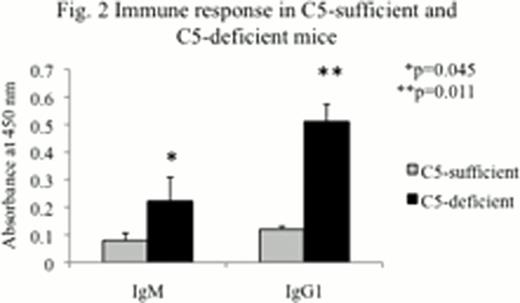Abstract
Abstract 3285
The complement system has complex activity that impacts on the immune response in a broad variety of ways. The current study was designed to assess the effect of complement components, specifically C5a, on the immune regulatory cells and on the development of an antigen-specific active immune response.
Myeloid dendritic cells (mDCs), enriched from healthy human peripheral blood mononuclear cells, were pulsed with antigen (tetanus toxoid) and co-cultured with autologous, enriched human CD4+ T cells in the presence of various purified complement components. The percent of CD4+ T-cells that were CD25highFoxp3+ (henceforth referred to as Tregs) was determined. The presence of cytokines in supernatant of mDCs cultured with purified complement proteins was also evaluated. In murine models, the effect of C5a on in vivo induction of Tregs and on the development of immune response to ovalbumin was determined by analyzing anti-ovalbumin antibody. This was done in C5-sufficient (B10-D2-HC1) and C5-deficient (B10-D2-HC0) mice immunized with 100 μg of ovalbumin, and in wild type C57Bl/6 mice immunized with 100 μg of ovalbumin along with either irrelevant rat IgG2a (Ova+Isotype control) or rat anti-mouse C5a antibody (Ova+anti-C5a Ab).
After mDC-CD4+T cell co-culture, C5a significantly increased the number of Tregs compared to media alone (p=0.0039) or other complement proteins (C1q, C3a, C3b) (Fig 1).
mDCsthat were stimulated by C5a produced increased amounts of IL-10 and TGFβ, and decreased IL-6.
Immunization of C5-deficient mice with ovalbumin resulted in significantly higher anti-ovalbumin IgM and IgG1 responses compared to C5-sufficient mice (Fig. 2; p=0.045 and 0.011, respectively). In addition, C5-deficient mice had fewer circulating Tregs compared to C5-sufficient mice.
C5a-depleted C57Bl/6 mice (Ova+anti-C5a Ab) had a significantly higher antigen-specific IgM response than C5a-intact mice (Ova+Isotype control) (Fig. 3; p=0.017).
Presence of C5a in the immune microenvironment results in increased generation of Treg cells and leads to dampening of antigen-specific immune responses. Absence or depletion of C5a results in a drop in the Tregs and a higher antigen-specific immune response. Ongoing studies are exploring the use of C5a depletion as a novel strategy to overcome the low immunogenicity of vaccines, such as cancer vaccines.
No relevant conflicts of interest to declare.
Author notes
Asterisk with author names denotes non-ASH members.




This feature is available to Subscribers Only
Sign In or Create an Account Close Modal